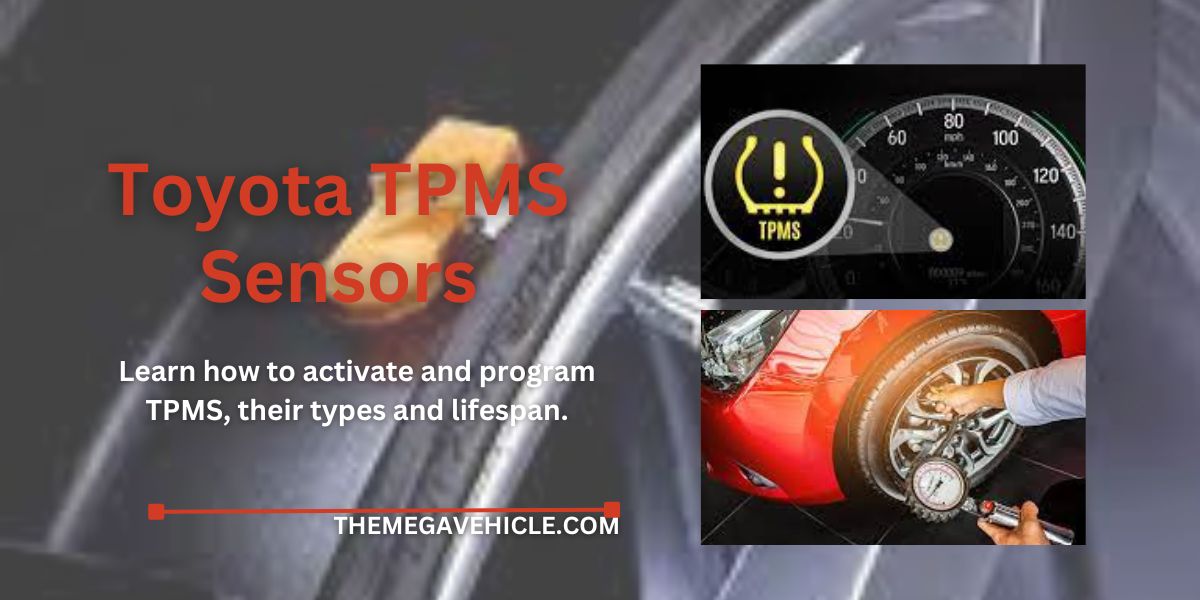Toyota TPMS Sensors: Everything You Need to Know

What are Toyota TPMS sensors?
Toyota TPMS sensors (Tire Pressure Monitoring System) are small, battery-powered devices that are installed inside each tire. They use a wireless signal to transmit real-time tire pressure data to the vehicle’s TPMS system. If the air pressure in any tire drops below a certain threshold, the TPMS system will illuminate a warning light on the dashboard.
Why are Toyota TPMS sensors important?
TPMS sensors are important because they help to ensure that your tires are properly inflated. Underinflated tires can lead to a number of serious problems, including:
- Reduced fuel efficiency: Underinflated tires create more friction between the tire and the road, which reduces fuel efficiency.
- Increased tire wear: Underinflated tires wear out more quickly than properly inflated tires, leading to increased replacement costs.
- Reduced handling and performance: Underinflated tires can make it more difficult to steer and brake, and can also reduce overall vehicle performance.
- Increased risk of tire failure: Underinflated tires are more likely to fail, which can lead to a blowout and potentially catastrophic consequences.
Toyota TPMS sensors help to prevent all of these problems by alerting you to any changes in tire pressure so that you can take corrective action before it’s too late.
Benefits of Toyota TPMS sensors
Toyota TPMS sensors offer a number of important benefits, including:
- Improved safety: By helping you to maintain proper tire pressure, TPMS sensors can help to reduce the risk of tire failure and other accidents.
- Increased fuel efficiency: Properly inflated tires improve fuel efficiency, saving you money at the pump.
- Extended tire life: Properly inflated tires last longer, saving you money on tire replacements.
- Reduced environmental impact: By reducing fuel consumption and tire waste, TPMS sensors can help to protect the environment.
Are All Toyota TPMS Sensors the Same?
Not all Toyota TPMS sensors are the same. There are two main types of TPMS sensors used by Toyota: direct TPMS sensors and indirect TPMS sensors.
- Direct TPMS sensors: Direct TPMS sensors are installed inside each tire and measure the actual air pressure in the tire using a pressure transducer. They are the more accurate type of TPMS sensor, but they are also more expensive.
- Indirect TPMS sensors: Indirect TPMS sensors do not measure the actual air pressure in the tire. Instead, they monitor the speed of each wheel using the vehicle’s speed sensors. If one wheel is spinning more slowly than the others, it may be a sign that the tire pressure is low. Indirect TPMS sensors are less expensive than direct TPMS sensors, but they are also less accurate.
OEM vs aftermarket TPMS sensors
Original equipment manufacturer (OEM) TPMS sensors are the same sensors that came with your Toyota vehicle when it was new. Aftermarket TPMS sensors are made by third-party companies and are designed to be compatible with Toyota vehicles.
OEM TPMS sensors are generally more expensive than aftermarket sensors, but they are also more reliable. Aftermarket TPMS sensors can be a good option if you are on a budget, but it is important to choose a reputable brand.
Compatibility with different Toyota models and years
TPMS sensors are not universal. Different Toyota models and years use different types of TPMS sensors. It is important to make sure that you choose the correct TPMS sensors for your vehicle.
You can find the correct TPMS sensors for your vehicle by using the Toyota parts catalog or by contacting your local Toyota dealer.
Here is a table of the different types of TPMS sensors used by Toyota and the models and years they are compatible with:
| TPMS sensor type | Models and years |
|---|---|
| Direct TPMS sensor | Camry (2007-present), Corolla (2009-present), RAV4 (2006-present), Highlander (2008-present), Sienna (2008-present) |
| Indirect TPMS sensor | Tacoma (2005-present), Tundra (2007-present), Sequoia (2008-present), 4Runner (2006-present), Land Cruiser (2008-present) |
How to choose the right Toyota TPMS sensors
When choosing TPMS sensors for your Toyota vehicle, there are a few factors to consider:
- Type of TPMS sensor: Determine which type of TPMS sensor is compatible with your vehicle. This information can be found in your vehicle’s owner’s manual or by contacting your local Toyota dealer.
- OEM vs aftermarket: Decide whether to purchase OEM or aftermarket TPMS sensors. If you are on a budget, aftermarket sensors can be a good option, but be sure to choose a reputable brand.
- Compatibility: Make sure that the TPMS sensors you choose are compatible with your vehicle’s model and year.
How Long Do Toyota TPMS Sensors Last?
Toyota TPMS sensors typically last for 7-10 years. However, the battery in a TPMS sensor can only last for 5-7 years. So, even if the TPMS sensor itself is still in good condition, you may need to replace the battery if the sensor is not working properly.
Factors affecting TPMS sensor lifespan
The lifespan of a TPMS sensor can be affected by a number of factors, including:
- Driving habits: If you drive on rough roads or in extreme weather conditions, your TPMS sensors may wear out more quickly.
- Tire pressure: If you do not maintain proper tire pressure, your TPMS sensors may work harder than they need to, which can shorten their lifespan.
- Corrosion: TPMS sensors can corrode over time, especially if they are exposed to salt or other harsh chemicals.
Signs of a failing TPMS sensor
There are a few signs that may indicate that a TPMS sensor is failing:
- The TPMS warning light on the dashboard is on.
- A TPMS sensor error message is displayed on the instrument cluster.
- One tire is consistently underinflated.
- The TPMS system does not work properly, such as not warning you when a tire is low on air.
How to tell which TPMS sensor is bad
To tell which TPMS sensor is bad in a Toyota vehicle, you can follow these steps:
- Turn the ignition switch to the “ON” position. Do not start the engine.
- Press and hold the TPMS reset button on the dashboard for 3 seconds. The TPMS light will start to flash.
- Release the reset button and wait for the TPMS light to stop flashing. This will take about 10 seconds.
- The TPMS light will then start to flash in a specific sequence. The number of flashes indicates which TPMS sensor is bad.
Here is a table of the TPMS sensor flash codes:
| Flash code | TPMS sensor |
|---|---|
| 1 flash | Front left TPMS sensor |
| 2 flashes | Front right TPMS sensor |
| 3 flashes | Rear left TPMS sensor |
| 4 flashes | Rear right TPMS sensor |
| 5 flashes | Spare tire TPMS sensor |
Once you have identified which TPMS sensor is bad, you can replace it yourself or take your vehicle to a qualified mechanic.
If the TPMS light flashes more than 5 times, then there is a problem with the TPMS system itself. You will need to take your vehicle to a qualified mechanic to have the TPMS system diagnosed and repaired.
When to replace TPMS sensors
If you notice any of the signs of a failing TPMS sensor, you should have the sensor replaced by a qualified mechanic. It is also recommended to have your TPMS sensors inspected and serviced regularly, especially if you drive in harsh conditions.
How to optimize Toyota TPMS sensors
To ensure that your Toyota TPMS sensors are working properly, it is important to follow these tips:
- Check your tire pressure regularly, even if the TPMS light is not on. TPMS sensors can only detect changes in tire pressure, so it is important to check the pressure manually to ensure that it is within the recommended range.
- Have your TPMS sensors inspected and serviced regularly by a qualified Toyota technician. This will help to ensure that the sensors are working properly and that the batteries are not low.
- Replace your TPMS sensors when they reach the end of their lifespan. TPMS sensors typically have a lifespan of 5-7 years, but this can vary depending on driving conditions and other factors.
- If you are replacing your tires, make sure to have the new tires installed by a qualified mechanic who can also program the TPMS sensors.
How to Activate and Program Toyota TPMS Sensors
If you have installed new TPMS sensors in your Toyota vehicle, you will need to activate and program them before they will work properly. This can be done using a TPMS scan tool or by following a TPMS relearn procedure.
How to activate TPMS sensors in Toyota
To activate TPMS sensors in a Toyota vehicle, follow these steps:
- Park the vehicle on a level surface.
- Turn the ignition switch to the “ON” position.
- Press and hold the TPMS reset button on the dashboard for 3 seconds. The TPMS light will start to flash.
- Release the reset button and wait for the TPMS light to turn off.
- Repeat steps 3 and 4 for each TPMS sensor.
How to program TPMS sensors in Toyota vehicles
There are two ways to program TPMS sensors in a Toyota vehicle: using a TPMS scan tool or using a TPMS relearn procedure.
Using a TPMS scan tool
A TPMS scan tool is a specialized tool that can communicate with the TPMS system in your vehicle. It can be used to read and write sensor data, as well as to diagnose and troubleshoot TPMS problems.
To program TPMS sensors using a TPMS scan tool, follow these steps:
- Connect the TPMS scan tool to your vehicle’s OBD-II port.
- Turn the ignition switch to the “ON” position.
- Select the TPMS programming function on the scan tool.
- Follow the instructions on the scan tool to program each TPMS sensor.
Using a TPMS relearn procedure
If you do not have a TPMS scan tool, you can program TPMS sensors using a TPMS relearn procedure. The TPMS relearn procedure is a specific sequence of steps that you must follow to program the TPMS system in your vehicle to recognize the new sensors.
The TPMS relearn procedure will vary depending on the make and model of your vehicle. You can find the TPMS relearn procedure for your Toyota vehicle in your vehicle’s owner’s manual.
Here are some general tips for programming TPMS sensors:
- Make sure that you are using the correct TPMS sensors for your vehicle.
- Follow the instructions carefully to avoid damaging the TPMS sensors or the TPMS system.
- If you are having trouble programming the TPMS sensors, take your vehicle to a qualified mechanic for assistance.
Specific instructions for programming TPMS sensors on popular Toyota models
| Toyota model | Year | Programming method |
|---|---|---|
| Camry | 2007-present | TPMS scan tool |
| Corolla | 2009-present | TPMS scan tool |
| RAV4 | 2006-present | TPMS scan tool |
| Highlander | 2008-present | TPMS scan tool |
| Sienna | 2008-present | TPMS scan tool |
| Tacoma | 2005-present | TPMS relearn procedure |
| Tundra | 2007-present | TPMS relearn procedure |
| Sequoia | 2008-present | TPMS relearn procedure |
| 4Runner | 2006-present | TPMS relearn procedure |
| Land Cruiser | 2008-present | TPMS relearn procedure |
If you have any trouble programming the TPMS sensors in your Toyota vehicle, please consult your vehicle’s owner’s manual or contact a qualified mechanic for assistance.
Does a Toyota spare tire have TPMS?
Not all Toyota spare tires have TPMS. Toyota started installing TPMS sensors in spare tires on some models in 2009. However, not all models received TPMS sensors in the spare tire.
To check if your Toyota spare tire has TPMS, look for a rubber valve stem or TPMS sensor (metal valve stem). If the valve stem is made of metal, then your spare tire has TPMS.






